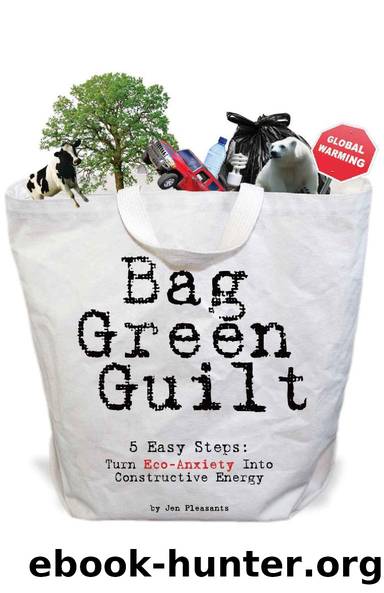Bag Green Guilt, Five Easy Steps: Turn Eco-Anxiety Into Constructive Energy by Pleasants Jen

Author:Pleasants, Jen
Language: eng
Format: epub
Publisher: Show The Love Media LLC
Published: 2009-04-04T00:00:00+00:00
Clothes
I am a clotheshorse and love to buy new clothes. I have been feeling guilty about buying clothes since as long as I can remem- ber. And for some women it is shoes or handbags in addition to clothes. We know we should be saving our money or spending on something less superficial, and now we have an even greater reason to feel rotten about buying new clothes: We are finally realizing that the Earth has limited resources, and the manufac- turing processes involved in making our high fashion statements are not healthy for our planet.
I love the kids’ site GreenEdgeKids.com. The folks there tell us what eco-friendly clothing means, and why we should buy it. They write:
“… you first need to understand what happens from the time that a cotton seed is planted to the time that a garment is sold. The conventional cotton T-shirt sold at your nearby department store has most likely has wreaked havoc on the environment and on people in each step of its long journey around the world to you. The typical story goes like this (it’s long, so get a cup of tea and relax while you read on):
First, a farmer plants cotton seeds in some country - China, USA, India, Pakistan, Brazil, Turkey (in order of the world’s greatest cotton producers), or perhaps some other country. Most of the time, seeds have been genetically modified, so the cotton plants are resistant to insects. As the plants are growing, plenty of fer- tilizer is applied. In addition, insecticides are applied to kill trou- blesome pests, and herbicides are used to kill weeds around the plants. This sounds convenient, but as time passes, even higher doses of chemical pesticides and herbicides are needed on the farm to kill the pests and the weeds. Herbicides are used again right before picking the cotton, to make the picking process eas- ier. Huge quantities of extremely toxic chemicals are used in this type of cotton farming, and guess where these chemicals go as soon as it rains or the farm is irrigated... right into someone’s drinking water downstream! Did you know conventional cotton farming accounts for 25% of worldwide insecticide use, accord- ing to the Organic Trade Association? The farmer then harvests the cotton and brings it to a gin to separate the cotton fiber from the seeds. From there, it may go to another country for fabric production.”
Basically a whole lot of pesticides get dumped on cotton, poi - soning our environment. That is a great reason to buy organic cotton products. Bamboo is supposed to be better than cotton because it is a sustainable product but there is still controversy over the way some people are manufacturing the fabric made from bamboo plants.
And by the way, you know what drives crazy? When you see a truly cute tee-shirt that says something like ‘Save the Planet!’ and it is made from non-organic cotton. What were they think- ing?!
According to Virgina Ginsburg, green living expert who runs GreenBabyGiftsOnline.
Download
This site does not store any files on its server. We only index and link to content provided by other sites. Please contact the content providers to delete copyright contents if any and email us, we'll remove relevant links or contents immediately.
Goodbye, Things by Fumio Sasaki(8422)
The Road Less Traveled by M. Scott Peck(7472)
Daring Greatly by Brene Brown(6367)
Big Magic: Creative Living Beyond Fear by Elizabeth Gilbert(5552)
Grit by Angela Duckworth(5446)
Discipline Equals Freedom by Jocko Willink(5238)
Ego Is the Enemy by Ryan Holiday(5224)
The Wisdom of Sundays by Oprah Winfrey(5047)
The Laws of Human Nature by Robert Greene(4921)
You Are a Badass at Making Money by Jen Sincero(4728)
Influence: The Psychology of Persuasion by Robert B. Cialdini(4661)
The Miracle Morning by Hal Elrod(4495)
Rising Strong by Brene Brown(4340)
Reflections Of A Man by Mr. Amari Soul(4207)
A Simplified Life by Emily Ley(4064)
The Power of Positive Thinking by Norman Vincent Peale(3954)
Seriously... I'm Kidding by Ellen DeGeneres(3510)
How to Win Friends and Influence People in the Digital Age by Dale Carnegie & Associates(3464)
The Courage to Be Disliked by Ichiro Kishimi & Fumitake Koga(3349)
